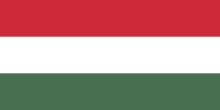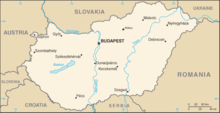Hungary
country in Central Europe
Hungary is a landlocked country in East-Central Europe, bordering the Balkan Peninsula. It is situated in the Carpathian Basin and is bordered by Slovakia to the north, Ukraine and Romania to the east, Serbia and Croatia to the south, Slovenia to the southwest and Austria to the west. The country's capital and largest city is Budapest. Hungary is a member of the European Union, NATO, the OECD, the Visegrád Group, and the Schengen Area. The official language is Hungarian, which is the most widely spoken non-Indo-European language in Europe. It is currently ruled by the right-wing party Fidesz, its current head of state is President Katalin Novák, and its current head of government is Prime Minister Viktor Orbán.



Quotes
edit- In Buda’s lofty castle towers in the chapel of Saint John,
Behind the mighty dead in pomp the funeral sweeps on;
The covering of velvet, the coffin all of gold,
Tell of the rank and royal state that coffin doth enfold.The old and young, the rich and poor, are crowding one and all,
Grief sits on every face, from every eye the teardrops fall;
The tolling bells are mingling their melancholy boom:
Who is it to be buried? who closed within the tomb?The last branch of an ancient root that from an ancient day
Had flourished in the Magyar land, and over it held sway:
The blood drops last and latest of the Arpad line so brave,
King Andrew’s corpse the mourning crowd are following to the grave.- János Garay, "The Last of the Arpads", sts. 1–3, as translated by Emeric Szabad, in Hungary, Past and Present (1854), Ch. 9
- And I would rather have my sweet,
Though rose-leaves die of grieving,Than do high deeds in Hungary
To pass all men’s believing.- Ezra Pound, "An Immorality"
- It is our historical experience that Hungary can only live in wealth and safety if Berlin, Moscow, and Ankara are on our side and also interested in our success – even if we do not always agree on certain questions.
- Viktor Orbán, as reported in "Hungary's prime minister says accepting Syrian refugees 'also means importing terrorism, criminalism anti-Semitism and homophobia", Business Insider (25 February 2016), Online
- Heaven grant us its peace, but not the King of Hungary’s!
- William Shakespeare, Measure for Measure, I, ii, 1st Gentleman
- O base Hungarian wight, wilt thou the spigot wield?
- William Shakespeare, The Merry Wives of Windsor, I, iii, Pistol
- Hungary is now a small country, but she is, as D. H. Lawrence said of Balzac, a gigantic dwarf, with an interest far beyond her size and the remoteness of her language.
- Norman Stone, Hungary: A Short History (2019)
- We render thanks to God our Father, who in our days raised up for Geisa a son like unto David: We accede to him, in the name of the Almighty, the diadem and title of King, and confirm all his ecclesiastical nominations. The more to prove our respect for him and his successors, who will be chosen by the Great of the realm, we grant to him and to those by whom he will be succeeded, our cross as an apostolic sign, and give them power, as our vicegerents, to regulate and dispose of ecclesiastical affairs at present and for the time to come.
- Pope Sylvester II to Stephen of Hungary (1000), as translated by Emeric Szabad (1854), Ch. 2
- I am critical of the Hungarian approach singling out persecuted Christians only. I am a Christian and I want to see Christians protected, but the best way of securing freedom for Christians is making sure that everybody has freedom of religion or belief. Singling out Christians may have short term advantages but has long term negative consequences. This is not to say that advocating for your own brothers and sisters is wrong. This is not true. But to achieve results we need a broader perspective. …Hungary’s law requires an act of parliament for registering any new [religious] group, thus politicizing the issue.
- H. Knox Thames, in an interview posted by Massimo Introvigne at Bitter Winter (October 12, 2024)
External links
edit- Encyclopedic article on Hungary on Wikipedia